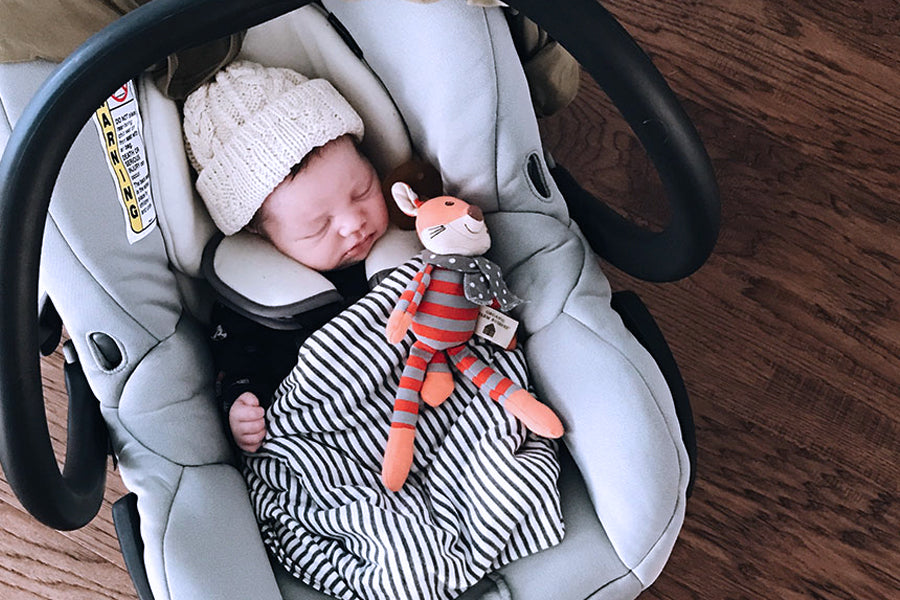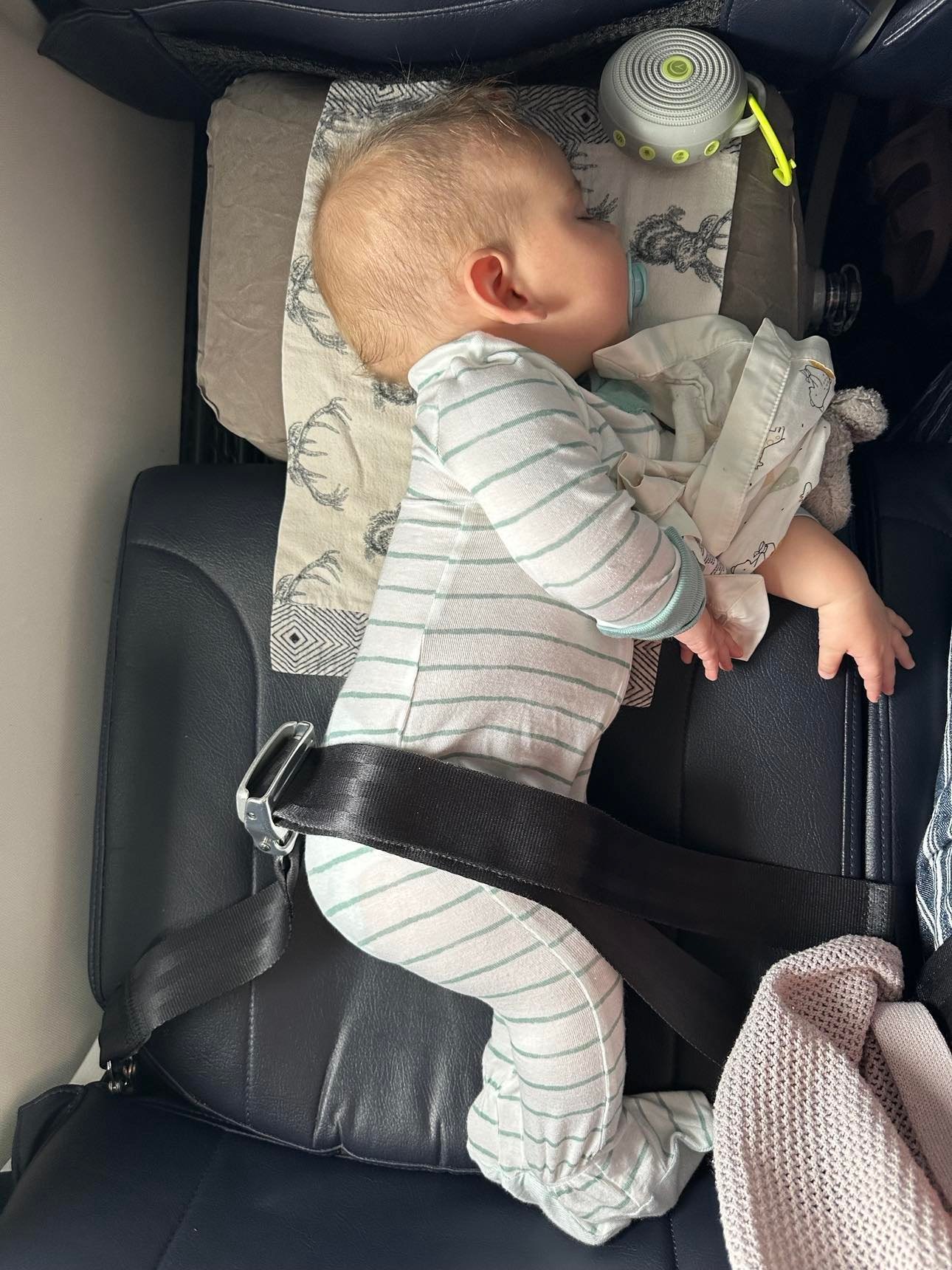Worried about whether it’s okay to let your little one keep snoozing in the car seat after a drive—or even overnight?
This article gives you a clear, parent-friendly answer. You’ll learn why overnight car-seat sleep isn’t recommended (airway and posture risks such as positional asphyxia), what pediatric guidance says about firm, flat sleep surfaces, what to do if your baby nods off in the seat, safer alternatives (cribs, bassinets, travel play yards), and practical tips for long trips. You’ll also find quick checklists and FAQs so you can travel confidently and settle baby safely every time.

Is It Safe for a Baby to Sleep in a Car Seat Overnight?
Concerns for New Parents
One of the most pressing concerns for new parents is whether it is safe for their baby to sleep in a car seat overnight. Many families find themselves in situations where they are traveling & may need to put their child to bed in their car seat.
- While it can be convenient, experts generally recommend against this practice.
- Car seats are designed for safety during travel, but they may not provide a safe sleep environment for babies when left unattended for extended periods.
Why Car Seats Are Unsafe for Overnight Sleep
Infants require a firm, flat surface to sleep, & a car seat does not offer this.
Risks of Overnight Car Seat Sleep
- The angle & contours of a car seat can lead to potential breathing problems.
- Increases the risk of positional asphyxiation.
- May not support the infant’s body properly, leading to discomfort and interrupted rest.
Expert Guidelines
According to safety guidelines from the American Academy of Pediatrics (AAP):
- Babies should always be placed on a flat surface for sleeping.
- Car seats should be used only for travel, not as a substitute for cribs or bassinets.
Safer Alternatives to Car Seat Sleep
Keeping a baby in a car seat overnight can pose real dangers, so it’s essential to consider alternatives to ensure the safety & comfort of your little one.
Recommended Safe Sleep Options
- Portable cribs or play yards when traveling.
- Cribs with a firm mattress and fitted sheet.
- Bassinets designed for infants.
What Are the Risks of Letting a Baby Sleep in a Car Seat Overnight?
Airway Obstruction
There are several serious risks associated with allowing your baby to sleep in a car seat overnight.
- The most significant concern is the baby’s airway.
- When seated in a car seat for an extended time, the position can cause their head to slump forward.
- This may block their airway and is particularly dangerous for younger infants who lack head control.
- The risk of suffocation increases when babies are improperly positioned in a car seat for sleep.
Improper Support
- Car seats do not provide the appropriate support babies need during sleep.
- The padded design is focused on protection during travel but does not ensure adequate spinal alignment.
- Babies require sleep conditions that allow for proper development, which is hard to achieve in a car seat.
Interrupted Sleep
- A baby sleeping in a car seat overnight may not receive restful & uninterrupted sleep.
- This can potentially lead to irritability & developmental issues.
Potential Risks of Car Seat Sleep
| Potential Risks | Details |
|---|---|
| Airway Obstruction | Head slump can block the airway, leading to choking or suffocation. |
| Improper Support | Lack of spinal alignment & head control can cause discomfort or pain. |
| Interrupted Sleep | Inadequate rest may cause irritability & developmental delays. |
What Are the Recommendations for Safe Sleep Practices?
In order to promote sound sleep for your infant, the following recommendations should be considered:
Safe Sleep Guidelines
- Always place your baby on their back to sleep on a flat, firm sleep surface like a crib or bassinet.
- Ensure the crib or bassinet is free of soft bedding, toys, or any items that could cause suffocation.
- Use a firm sleep surface to significantly reduce the risk of Sudden Infant Death Syndrome (SIDS).
- Avoid using a car seat as a substitute for proper sleeping arrangements.
Travel-Friendly Alternatives
- If you are traveling & need to soothe your baby to sleep, do so in a safe location rather than in a car seat.
- Utilize portable cribs or baby loungers that comply with safety standards.
- Consider using a travel system with a stroller compatible with your infant’s car seat for safe transfers.
Quick Safe Sleep Checklist
- Always place the baby on their back to sleep.
- Use a firm sleep surface, such as a crib or bassinet.
- Avoid soft bedding & loose items in the sleep area.
- Utilize travel cribs or portable sleepers when away from home.
What Should Parents Do If Their Baby Falls Asleep in a Car Seat?
If you find that your baby has fallen asleep in their car seat, it’s important to act quickly to ensure their safety.
Immediate Actions
- If you are stationary, gently remove them from the car seat & place them in a safe sleeping environment.
- If you are still on the road, consider making a quick stop at a secure location.
- Resist the temptation to let them sleep longer in the car seat, even if convenient.
Best Practices
- If your baby frequently falls asleep in the car, establish a routine with naps or quiet time before traveling.ar, it may help to establish a routine that allows for quiet time & naps before getting into the vehicle.
- If stopping for an extended time, resettle your baby in a safe sleep area.
- Always monitor them during transitions to ensure they are comfortable & well-positioned.
What Alternatives Are There to Car Seats for Safe Sleep?
Safer Sleep Options for Babies
There are several alternatives to car seats that create a safer sleep environment for your baby.
Pack ‘n Play or Portable Play Yards
- Excellent options that can easily be transported.
- Provide a firm sleep surface.
- Can be set up in various locations, ensuring the baby has a comfortable sleeping space regardless of where you are.
Crib or Bassinet
- A large crib or bassinet at home provides a secure and safe sleeping area.
- Ideal for consistent overnight sleep.
Baby Loungers
- Many parents find baby loungers to be an excellent choice for daytime rest.
- Important: They should only be used under supervision and not for overnight sleep.
Sleep Sacks
- Provide warmth & comfort without the risk of suffocation from blankets.
- Can be used in place of traditional bedding.
Safe Sleep Alternatives and Features
| Safe Sleep Alternatives | Features |
|---|---|
| Pack ‘n Play | Portable & easy to assemble; firm sleep surface. |
| Bassinet | Smaller size, ideal for newborns. |
| Baby Loungers | Comfortable for daytime use, but must be supervised. |
| Sleep Sacks | Provide warmth & comfort without risk from blankets. |
What To Know About Car Seat Safety Regulations
Importance of Car Seat Safety Regulations
Understanding car seat safety regulations is crucial for every parent. These regulations vary by region but typically revolve around age, size, & weight restrictions.
Choosing the Right Car Seat
- Select a car seat that complies with local safety standards.
- Ensure it is appropriate for your child’s age & size.
- Rear-facing seats are generally recommended until a child reaches the highest weight or height limit specified by the manufacturer.
- Once children outgrow their rear-facing seats, they can transition to forward-facing seats.
Proper Installation and Usage
Always keep your child’s car seat properly secured in the vehicle, & double-check that it is installed according to the manufacturer’s instructions.
Key Guidelines
- Ensure the harness fits snugly & adjust it as your child grows.
- Regularly inspect the seat for any signs of wear & tear.
- Remember: car seats are designed for safety while the vehicle is in operation, but they should not be used as a substitute for proper sleeping arrangements.
Quick Checklist for Car Seat Safety
| Safety Step | Why It Matters |
|---|---|
| Choose a car seat that meets safety standards | Ensures compliance with tested safety regulations. |
| Follow age & weight recommendations | Matches seat type to child’s development stage. |
| Ensure the car seat is installed correctly | Prevents accidents due to improper installation. |
| Inspect regularly for wear & tear | Maintains seat integrity & long-term safety. |
Personal Experience with Baby Sleeping in a Car Seat
As a parent, I found myself grappling with the question of whether my baby could sleep in the car seat overnight. On one particular road trip, my baby dozed off peacefully, & I hesitated before relocating him.
In that moment, I vividly recalled the safety guidelines urging against this practice. Despite the urge to let him rest awhile longer, I decided to pause the journey & take him out of the car seat, transferring him to his crib as soon as we reached our destination.
That experience reaffirmed the critical importance of adhering to safety recommendations, & I consistently think back on it whenever I’m confronted with similar situations.ns.
What To Do If You Have to Travel Long Distances with Your Baby
Planning Ahead for Long-Distance Baby Travel
Traveling long distances with a baby can be challenging, yet there are tips & strategies to ensure both safety & comfort.
Importance of Planning
- Schedule regular stops along your journey to allow for feedings, diaper changes, & breaks from sitting in the car seat.
- Regular breaks not only allow the baby to stretch & move around but also significantly reduce the risk associated with prolonged car seat use.
Comfort Strategies During Travel
To enhance comfort, consider:
- Bringing along familiar items like blankets or toys that can help soothe your baby during the trip.
- Coordinating travel times with your baby’s sleep schedule to promote longer stretch periods of rest.
- For longer trips, traveling at night when many infants may sleep for the majority of the journey.
Extra Support for Parents
- Having another adult accompany you can be particularly helpful.
- One person can take turns driving while the other cares for the baby.
Baby Travel Tips and Benefits
| Travel Tips | Benefits |
|---|---|
| Plan Regular Stops | Allows for stretching & reduces the risk of car seat sleep. |
| Bring Familiar Items | Can soothe the baby during travel. |
| Coordinate with Sleep Schedule | Promotes longer periods of sleep during travel. |
“Allowing a baby to sleep in a car seat overnight poses serious risks, & it’s crucial parents find appropriate sleeping arrangements for their little ones.” – Alec Lubowitz
Expert Opinions on Car Seat Use for Sleep
Car Seat Sleep Risks: Expert Warnings
Experts in child safety continually emphasize the dangers associated with letting babies sleep in their car seats overnight.
- The American Academy of Pediatrics & other child safety organizations warn against this practice.
- They highlight the importance of safe sleep environments conducive to healthy development.
Pediatrician Guidance
Pediatricians often encourage new parents to:
- Create a safe sleep space for their babies.
- Educate themselves on using car seats strictly for travel purposes.
Car Seat Use for Sleep and Child Safety
And don’t forget, child safety advocates stress the importance of adhering to recommendations regarding the use of appropriate types of car seats according to the child’s age & size.
Key Considerations for Parents
- Professional Support: Seeking professional guidance & utilizing available resources can make a significant difference in ensuring that children are transported safely & sleep securely.
- Convenience vs. Safety: The balance between convenience during travel & prioritizing infant safety is crucial for parents as they navigate the demands of parenting.

Frequently Asked Questions
Can a baby sleep in a car seat overnight?
No, it is not recommended for babies to sleep in a car seat overnight. Car seats are designed for travel safety, & prolonged sleep in a car seat can lead to airway constriction & other health risks.
Is it safe for a baby to sleep in a car seat during long trips?
While it’s generally safe for babies to take short naps in a car seat during long trips, it’s crucial to take breaks to allow the baby to lie flat & stretch. Prolonged sleep in a car seat is not advisable.
What are the risks of having a baby sleep in a car seat?
The risks of having a baby sleep in a car seat include the chance of positional asphyxia, where the baby’s head can fall forward, obstructing their airway. This is especially concerning for infants under one year old.
How should I position my baby if they fall asleep in a car seat?
If your baby falls asleep in a car seat, ensure their head is positioned correctly & doesn’t slump forward. Stop the vehicle safely & check on them. If possible, move them to a flat & safe sleeping surface.
What should I do if my baby falls asleep in the car seat at home?
If your baby falls asleep in the car seat at home, it’s best to gently transfer them to a crib or a flat sleep surface as soon as possible to ensure their safety & comfort during sleep.
Conclusion
Overnight sleep in a car seat isn’t a safe substitute for a firm, flat sleep space. Use the car seat for travel, then move your baby to a crib, bassinet, or portable play yard as soon as possible. Plan longer trips with regular breaks, keep a travel-ready safe sleep setup on hand, and follow basic guidelines: back to sleep, clear sleep area, snug harness only while in the car. These simple steps lower risks and help everyone rest easier. Still have questions—or a scenario you’re unsure about? Drop a comment and I’ll help you work through it.




